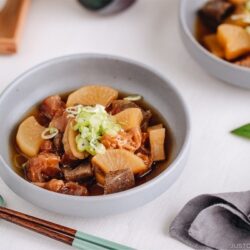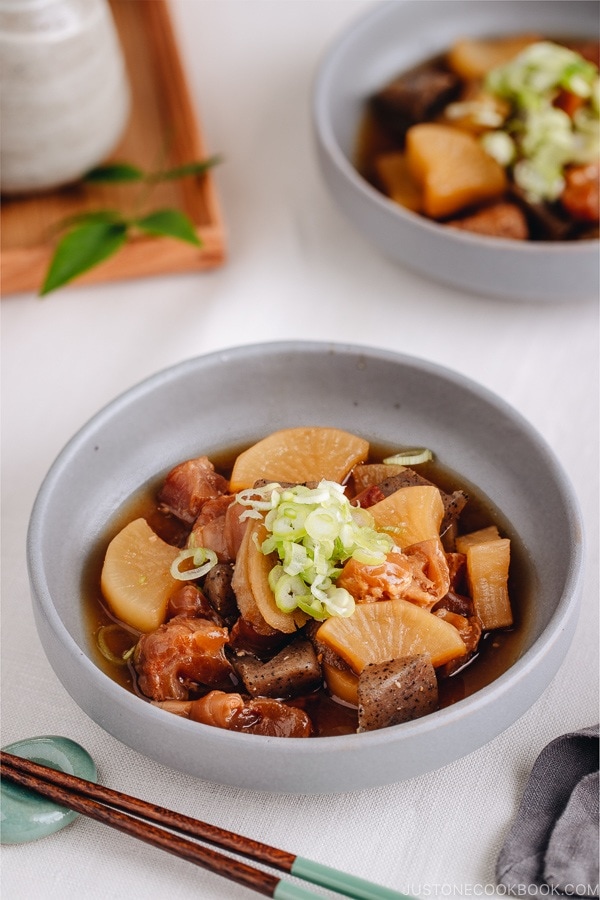
Beef tendon may not be a common ingredient in Western cultures, but it is loved for its luxurious textures and health benefits in Japanese and many Asian cuisines. Every now and then, I receive recipe requests for Japanese beef tendon dishes from readers who have tried and loved them. I procrastinated for a while but finally challenged myself to cook it for the very first time.
Today I present one of the most popular beef tendon dishes in Japan – Gyusuji Nikomi (牛筋煮込み) or Japanese Beef Tendon Stew.
What’s Beef Tendon?
Beef tendons are commonly used as an ingredient in some Asian cuisines and I’ve tried them in Chinese, Japanese, Korean, and Vietnamese food in the past.
Frankly speaking, they are not my favorite cut of meat because of the wobbly, flabby, jello-y texture (I like crispy and crunchy food). People who enjoy beef tendon appreciate the soft-tender texture and the rich flavors. Of course, they are high in collagen, which is good for your skin, joints, and hair.
Tendons are tough and fibrous but become tender after a long period of cooking. With the use of a pressure cooker, the cooking process can be shortened without compromising the perfect texture and delicious flavors. Properly cooked beef tendons contribute wonderful flavors to the final dish, with deep and rich broth and tendons that literally melt in your mouth.
Beef Tendon in Japanese Cuisine
Growing up in the Kanto (east) region of Japan, the beef tendon wasn’t a common cut of meat sold in regular grocery stores or on restaurant menus. Tendons are more popular and eaten in the Kansai and Kyushu (west/south) regions of Japan, probably due to the geographical distance to the neighboring Asian countries and their cuisine influence. You can find tendons used in stew, Oden, Doteni (どて煮), Okonomiyaki, Yakisoba, and Japanese curry in the west/south of Japan.
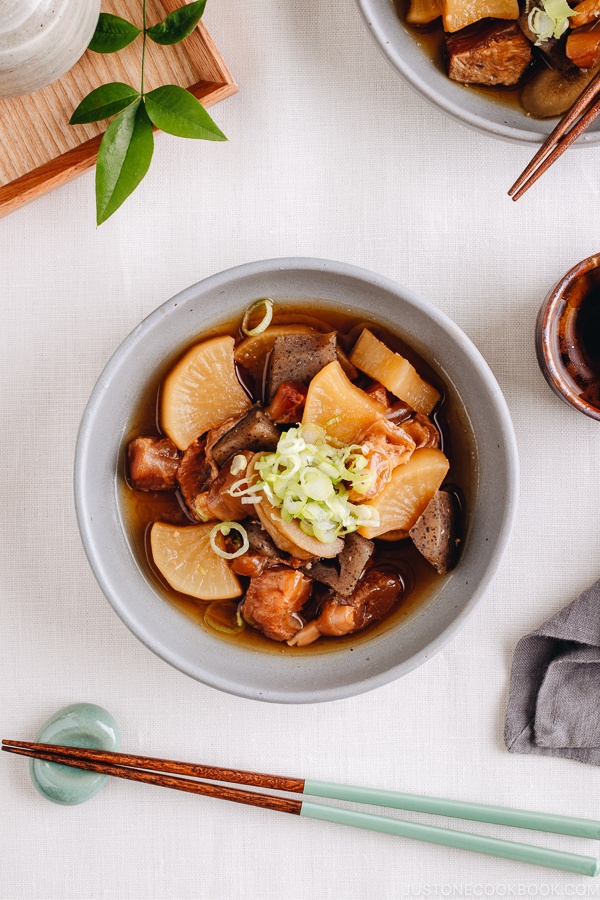
Japanese Beef Tendon Stew (Gyusuji Nikomi)
Gyusuji Nikomi (牛筋煮込み) is probably the most popular beef tendon dish in Japan. Gyusuji (牛筋) means beef tendons and nikomi means stew in Japanese.
Beef tendons are prepared first by boiling and simmering, and only after properly prepping, they are stewed in a soy sauce-based savory dashi broth with daikon. Some variations of the stew include konnyaku (konjac) and other root vegetables like carrots and gobo (burdock root).
Note that beef tendons sold in Japan often come with some meat. However, beef tendons I can find at Chinese grocery stores here in the US are usually just tendons without meat.
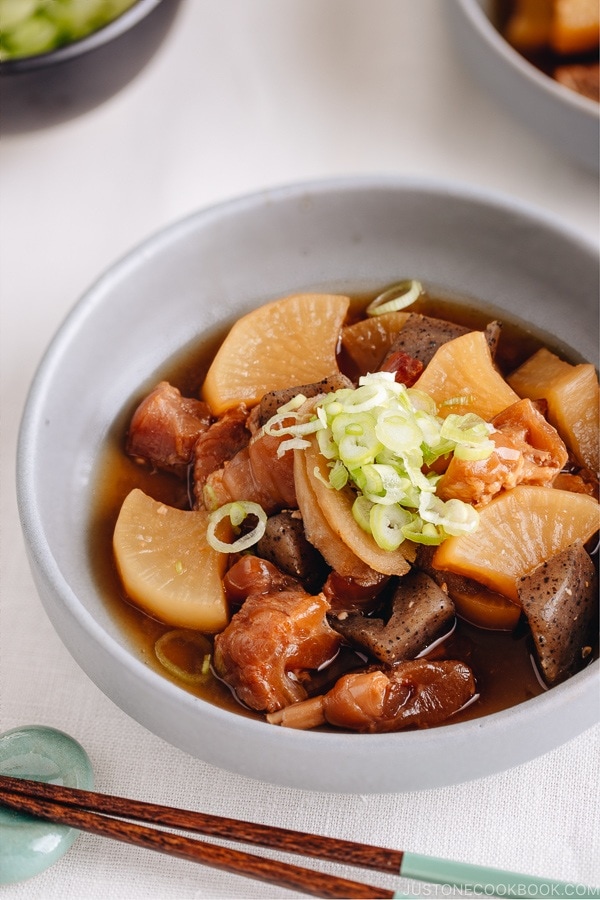
5 Steps to Prepare Japanese Beef Tendon Stew
It takes 5 steps to make the Gyusuji Nikomi properly, and here’s how:
Step 1: Boil Beef Tendons
Hot boiling water helps to rinse off any unpleasant smell of beef tendons, which determines the flavors of your final fish, so do not skip this most important step.
Step 2: Pressure Cook/Simmer with Aromatics
Next, we’ll simmer the tendons with aromatics like ginger and green onions to take care of any residual smell. To achieve the tenderness you’re looking for in a shorter cooking time, a pressure cooker comes in handy. If you’re using an electric pressure cooker, you can even leave the kitchen and do something else.
Step 3: Clean Tendons
Once pressure cooking is finished, you must clean every part of the tendons thoroughly. It’s important to work with clean tendons to get a clean taste.
Step 4: Pressure Cook/Simmer with Broth and Seasonings
Now that you have clean tendons, it’s time to add flavors to them in dashi and seasonings. We give the tendons a head start so they have more time to absorb flavors before adding other ingredients.
Step 5: Pressure Cook/Simmer with Other Ingredients
Finally add the other ingredients such as daikon, gobo (burdock root), and konnyaku. At this step, you just need to make sure daikon is fully cooked, without over or under-cooking.
Homey and comforting, this Japanese Beef Tendon Stew will warm your soul, especially this time of the year.
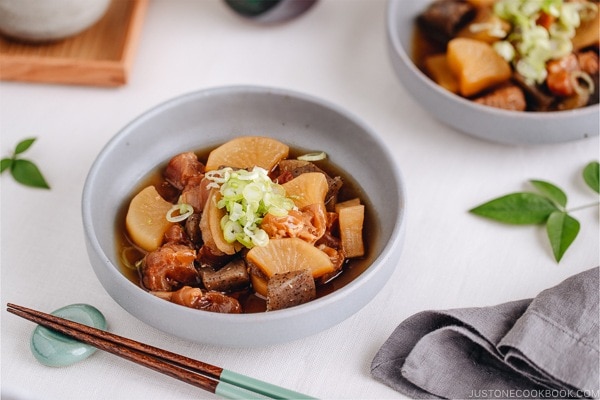
Wish to learn more about Japanese cooking? Sign up for our free newsletter to receive cooking tips & recipe updates! And stay in touch with me on Facebook, Pinterest, YouTube, and Instagram.
Japanese Beef Tendon Stew
Ingredients
- 1 lb beef tendon (rinsed and cleaned well)
- 1 knob ginger (1 inch, 2.5 cm)
- 3 green onions/scallions (separated into green and white parts)
- ⅔ block konnyaku (konjac) (6 oz, 170 g)
- ½ tsp Diamond Crystal kosher salt (for the konnyaku)
- 3 inches daikon radish (8 oz, 227 g)
- ½ gobo (burdock root) (2.1 oz, 60 g)
For the Seasonings
- 2 cups dashi (Japanese soup stock)
- 3 Tbsp sake
- 3 Tbsp sugar
- 4 Tbsp soy sauce
- 2 Tbsp miso
Instructions
- Gather all the ingredients.

- To an Instant Pot, add 1 lb beef tendon (rinsed and cleaned) and 4 cups water. Add more water to cover the tendon, if necessary.

- Press the Sauté button and change to your setting to More by pressing the Adjust button.

- Once boiling, press the Keep Warm/Cancel button on the Instant Pot to stop cooking. Take out the inner pot and discard the water.
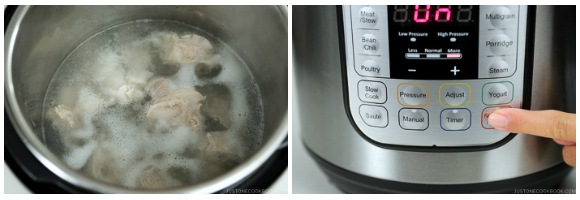
- Put the inner pot with the tendons back in the Instant Pot and add 4 cups water.
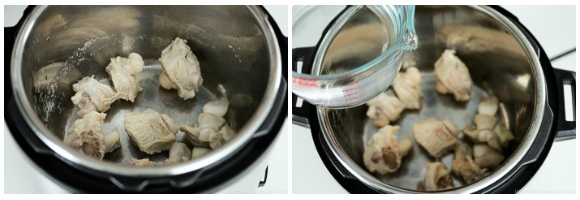
- Peel the skin of 1 knob ginger with the back of a knife or spoon and cut it into thin slices. Cut 3 green onions/scallions in half, reserving the white bottom part.
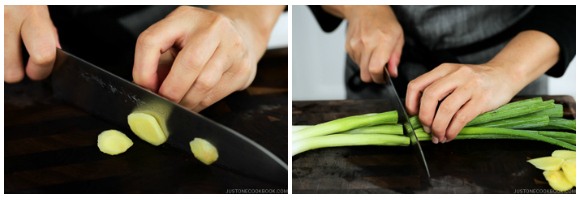
- To the Instant Pot, add the sliced ginger and green part of the green onions.
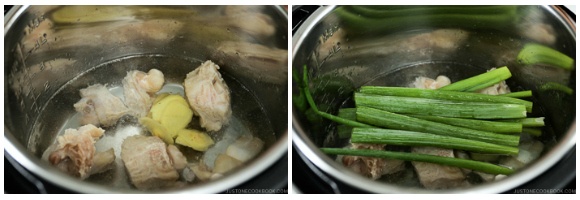
- Cover and lock the lid. Press the Manual button on the Instant Pot. Set High pressure for 30 minutes by pressing the + (plus) or – (minus) button to change the cooking time. Make sure the steam release handle points at Sealing and not Venting. The float valve goes up when pressurized. [For stovetop cooking, bring the water to boil and lower the heat to simmer and cook for 3 hours.]

To Prep the Other Ingredients
- Using a spoon to cut ⅔ block konnyaku (konjac) into bite-size pieces.
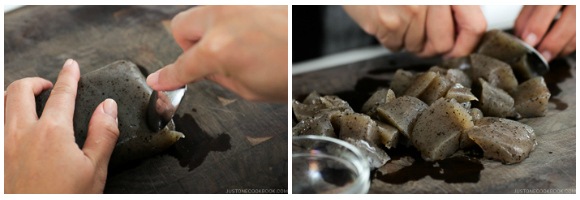
- Sprinkle ½ tsp Diamond Crystal kosher salt over the konnyaku and rub with your hands. Salt helps the konnyaku release unwanted odor and absorb flavors later on.
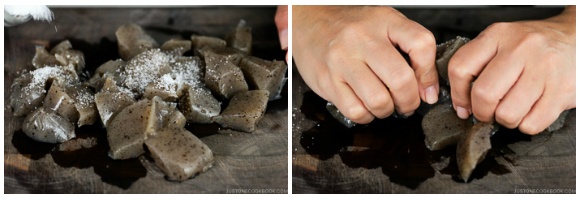
- Bring water to a boil and cook the konnyaku for 5 minutes.
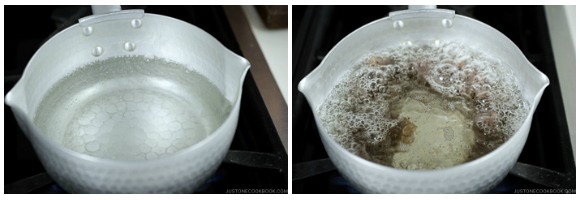
- Peel and cut 3 inches daikon radish into quarters lengthwise. Then, cut into ½-inch (1.25-cm) slices.

- Using the back of the knife, remove the thin layer of skin from ½ gobo (burdock root) (but do not peel as the gobo flavor is right under the skin). Then, diagonally cut the gobo into ⅛-inch (3-mm) slices. Soak in water to prevent it from changing colors.

- When it’s finished cooking, the Instant Pot will switch automatically to the Keep Warm mode. Let the pressure release naturally, about 15–20 minutes. Open the lid and take out the inner pot.
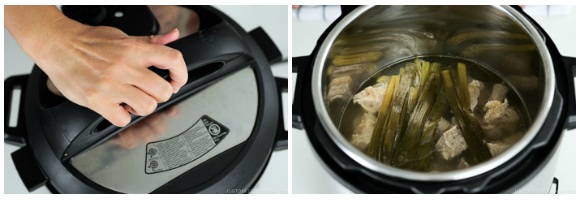
- Drain the cooking liquid and rinse under warm water. Discard the spent green onions and ginger.
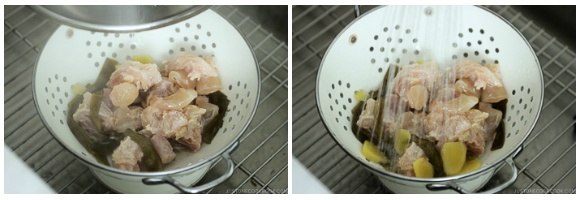
- Rinse every part of the tendons with warm water. Drain well and cut the tendons into small pieces. Put them in a bowl and set aside.
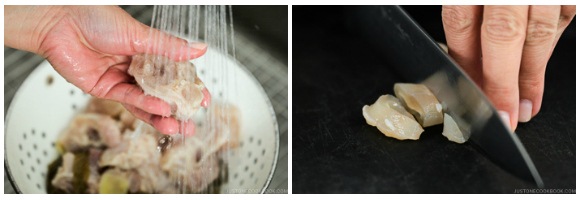
- Quickly rinse and dry the inner pot and place it back in the Instant Pot. Add 2 cups dashi (Japanese soup stock), 3 Tbsp sugar, and 3 Tbsp sake in the pot.

- Add 4 Tbsp soy sauce and 2 Tbsp miso, and mix well together.

- Put the cleaned beef tendons into the pot and mix together with the sauce.
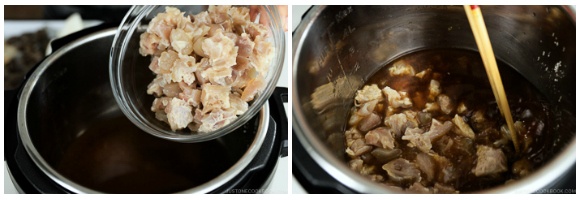
- Cover and lock the lid. Press the Manual button on the Instant Pot. Set on High pressure for 10 minutes by pressing the – (minus) button to change the cooking time. Make sure the steam release handle points at Sealing and not Venting. The float valve goes up when pressurized. [For stovetop cooking, bring the sauce to boil and lower the heat to simmer and cook for 1 hour.]
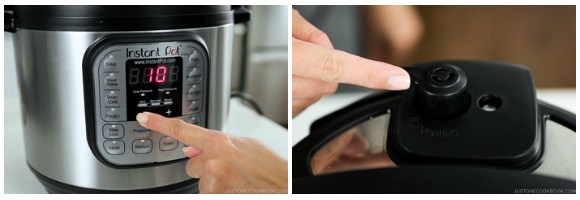
- When it’s finished cooking, the Instant Pot will switch automatically to the Keep Warm mode. Let the pressure release naturally for 15–20 minutes or proceed with the quick release by turning the steam release handle to the Venting position to let steam out until the float valve drops down. Hold a kitchen towel and do not place your hand or face over steam release valve.

- Add the konnyaku, daikon, and gobo.
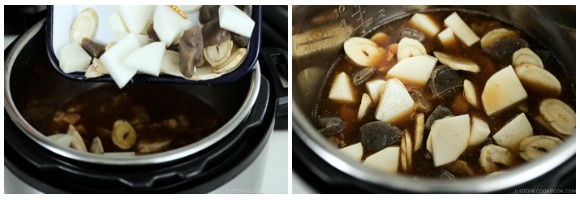
- Cover and lock the lid. Press the Manual button on the Instant Pot. Set on High pressure for 10 minutes. Make sure the steam release handle points at Sealing and not Venting. The float valve goes up when pressurized. [For stovetop cooking, bring the sauce to boil and lower the heat to simmer, and cook for 1 hour.]
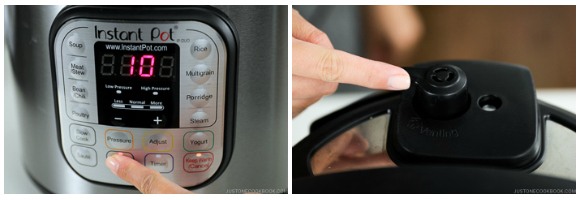
- When it’s finished cooking, the Instant Pot will switch automatically to the Keep Warm mode. Let the pressure release naturally for 15–20 minutes.
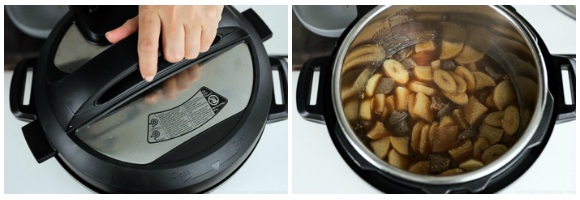
- Chop the reserved white part of the green onions into thin rounds. Serve the Japanese Beef Tendon Stew in a bowl and garnish with the chopped green onion. Serve warm.
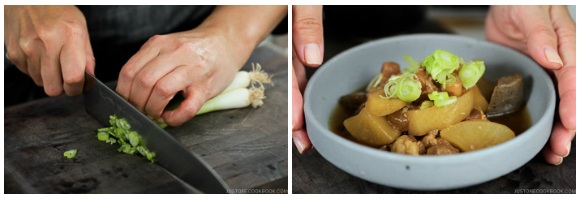
To Store
- You can store the leftovers in an airtight container and store in the refrigerator for up to 3 days. I don‘t recommend freezing as konnyaku will change the texture.
Nutrition
Did you make this recipe?
Tag @justonecookbook on Instagram so we can see your delicious creation!


